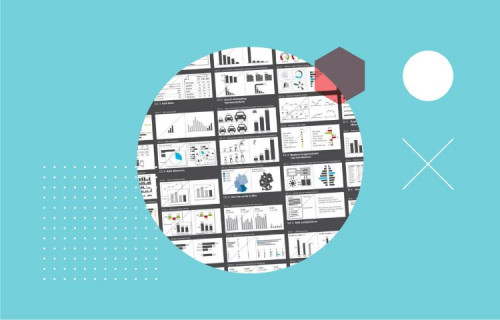
An interview with author and managing partner of the IBCS Assocation Jürgen Faisst
Recently we had the privilege to attend a workshop by Jürgen Faisst, managing partner of the IBCS Association and co-author of the book SOLID | OUTLINED | HATCHED. After the inspiring workshop, we had the chance to ask him a couple of questions regarding the International Business Communication Standards and his outlook on its future.
What are the International Business Communication Standards?
The International Business Communication Standards (IBCS) are set of rules for the design of reports, presentations and dashboards. These rules cover conceptual aspects. Let’s say the storytelling part and visual aspects like choosing the right chart type, increase information density and apply proper scaling. What sets IBCS apart from all other publications on data visualization? It’s a new class of visual rules covering the consistency of the design. Things that mean the same should always look the same. While this idea was originally invented by Prof. Rolf Hichert. IBCS today is a community-driven Creative Commons project.
Everyone can join the not-for-profit IBCS Association. Contribute to the Standards for free on www.ibcs.com. The idea is to let the business analysts community define their own visual language. Hopefully they will apply it consistently (and tell the software industry to do so).
In your book SOLID | OUTLINED | HATCHED, IBCS is often compared to sheet music. As an avid musician yourself, what are some of the parallels that you see between the world of music and the world of data visualization?
Well, if you step back a little and look at report creation as an act of recording the ideas of a business person on screen or on paper, then you immediately see the parallels. Writing music notes is exactly the same, just with the ideas of a musician. And by the way, creating construction plans is again the same, now with the ideas of an architect.
The difference is: Architects and musicians apply a standard notation when doing so, whereas business analysts just follow their personal preferences or do what they think is best. This is too bad because applying a standard notation does not only speed-up understanding by leveraging pattern recognition, it can even avoid running into issues. Let me give you an example from sheet music: How many keys does the keyboard of a grand piano have? I tell you: It’s 88. 88 different tones that can be played on a piano. Now if you want to these notes down on paper, you have to arrange black dots on and between five lines – this is how music is notated. And you immediately see: 88 notes do not fit into a system of five lines.
Ok, there are assisting lines, and signs for sharp and flat tones. But still: You can probably arrange 50 different tones, but definitely not 88. So we run into a scaling problem. Do we? No, we don’t. Because music notation invented something called clefs. The right hand of a piano player is notated in treble clef, the left hand in bass clef. All musical arrangers apply this rule –not because they see it as the solution to a scaling problem, but because this is the way everyone notates music. Mission accomplished.
What is the best way for a company to start with IBCS?
The best way is to make IBCS part of a project that will redesign reports and dashboards anyway. There are two main situations where this happens: (1) If you replace the BI platform – e.g. you want to use Power BI instead of Cognos, and (2) if the way you run the company changes, e.g. you reorganize control from central to decentral or you just get a new CFO. In these cases implementing IBCS is not an additional project with additional costs, but it facilitates the implementation of a project that is necessary in any case. If you on top of that make sure you’ve got management sponsorship on the subject and an IBCS compliant software in place then your journey toward IBCS will be a smooth one.
Do you have any tips for supporters?
The main tip is: Never argue with your peers that they should apply IBCS because it’s a standard. They do not give a shit about standards. It’s much easier to convince them by just creating better results. They will immediately see that the reports after a makeover are easier to understand. And if they ask what you did in order to achieve that you can smile and tell them: “I’ve simply applied a set of rules making reports better comprehensible. It’s called IBCS. And it’s free and openly available. You want to look at it?” This is the only way to increase adoption. Dogmatism will cause rejection.
You have worked with IBCS for several years now, what is the biggest success story that you can share with us?
There are lots of them, but maybe the biggest success story comes from SAP. The finance department of SAP became aware of IBCS many years ago and Rolf Hichert convinced the former CFO Werner Brandt that applying IBCS to their internal reports would facilitate understanding. So the finance department created some workaround with their own analytic software and redesigned their reports which are now reasonably IBCS compliant.
With the new SAP Analytics Cloud initiative, they have for the first time also taken IBCS principles into account in software development. This led to the IBCS certification of SAP Analytics Cloud in late 2017. Two years later they were recertified with extended IBCS functionality and better usability. This definitely helped raise the perception of IBCS as a mature report design concept.
What is your ultimate dream for IBCS in 3 to 5 years?
Let’s start with my ultimate dream: I would be more than happy to see the same natural use of standard notation in reporting as we see in almost any other discipline. To get there, it will be necessary to incorporate IBCS notation into the curriculum of business schools. 3 to 5 years is probably too short a time frame for this dream to come true. Give us 10 years for education and another 10 years before the students are in management positions. Then it took us a total of 30 years, which is still much faster than in all other disciplines. Musicians have taken centuries.
Want to know more about IBCS? Check out the IBCS section on our website or visit the IBCS website here.

Dashboards with Impact
In my eight years as a consultant, I’ve probably seen more dashboards than I can count. Still, most of them don’t have the impact they should have. Nine out of ten times, people start looking at the data. Is there something wrong with the underlying data-sets? Or is the visual not clear enough? Looking at those elements isn’t bad, but in my opinion, you’re looking in the wrong direction.

Gartner Magic Quadrant for Business Intelligence Platforms and Analytics 2020
The Gartner Magic Quadrant for Business Intelligence is a piece of analyst reporting we look forward to every year. Both the dept and the scope of this research makes it worth the read. But not many people take the time to really dig into the details of the report.
The Best Data Science Webinars
Day to day hectic is always the enemy of your ambition to acquire new skills and gain knowledge in the fields you identified. These special times offer the opportunity for some of us to spend some extra time to invest in yourself to learn new things. For those of you who have the ambition to learn more about data science we made a selection of the webinars from the people at Alteryx to learn more about this subject.